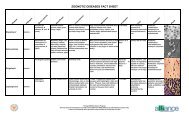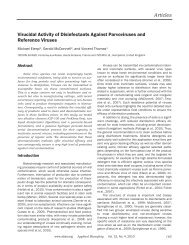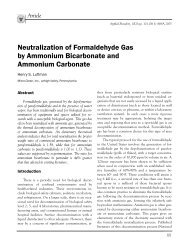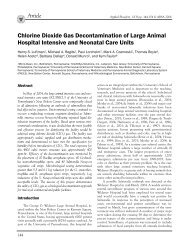Volume 10, Number 4, 2005 - American Biological Safety Association
Volume 10, Number 4, 2005 - American Biological Safety Association
Volume 10, Number 4, 2005 - American Biological Safety Association
You also want an ePaper? Increase the reach of your titles
YUMPU automatically turns print PDFs into web optimized ePapers that Google loves.
hosts. A probabilistic model can also account for<br />
variability in the value of psuccess between individual<br />
hosts.<br />
Figure 1 displays the data listed in Table 1, the<br />
best fit curves for the lognormal and Weibull model,<br />
and the PAV fit along with the 95% pointwise confidence<br />
interval for the PAV fit. Over the range of<br />
data (inhaled doses of <strong>10</strong> and greater), the lognormal,<br />
Weibull, and PAV fits are consistent (the<br />
lognormal and Weibull fits are within the 95% confidence<br />
interval for the PAV fit). The lognormal and<br />
Weibull models allow extrapolation to inhaled doses<br />
below <strong>10</strong> bacilli. The lognormal model parameter<br />
estimates (GM = 3.71, GSD = 6.01) indicate that<br />
infection risk given inhalation of one bacillus is<br />
23%, while the Weibull model parameter estimates<br />
( = 0.191, = 0.412) indicate that infection risk<br />
given inhalation of one bacillus is 40%. Overall, the<br />
lognormal and Weibull models suggest that 20% to<br />
40% of the population would be infected due to inhaling<br />
a single F. tularensis bacillus.<br />
The PAV fit indicates that inhaling <strong>10</strong> bacilli<br />
would infect approximately 30% of the population;<br />
unfortunately, this nonparametric model does not<br />
permit estimating the percent infected below the<br />
inhaled doses for which data are available. However,<br />
it does not make sense that <strong>10</strong> bacilli is the minimum<br />
inhalation infectious dose. If inhaling <strong>10</strong> organisms<br />
produces infection with 30% probability, it<br />
is reasonable that inhaling 9 organisms should produce<br />
infection with some probability less than 30%<br />
but greater than zero, unless infection is a multihit<br />
process requiring a minimum of <strong>10</strong> organisms. In<br />
regard to the latter idea, we note that the infectivity<br />
of just one F. tularensis organism is supported by animal<br />
data. In mice, guinea pigs, and rabbits, the intracutaneous<br />
and intraperitoneal injection of a single<br />
F. tularensis bacterium is capable of producing<br />
lethal disease (Bell, Owen, & Larson, 1955; Downs<br />
et al., 1947; Emel’yanova, 1961; Rosebury, 1947).<br />
The distributions depicted in Figure 1 are somewhat<br />
confused by aggregating the results from aerosol<br />
exposure studies involving different or unknown<br />
particle size distributions. McCrumb (1961) did not<br />
specify the particle size distribution or describe the<br />
aerosol generating equipment, while Sawyer et al.<br />
(1966) considered the dose to be only those organ-<br />
R. M. Jones, et al.<br />
isms present in particles of diameter 5 m or less.<br />
Because particle size is inversely related to infectivity<br />
(Day & Berendt, 1972), we applied the same statistical<br />
analyses to the data of Saslaw et al. (1961) for<br />
which the aerosol size distribution was described as<br />
homogeneous with an average particle diameter of<br />
0.7 m. We also decreased Saslaw’s reported inhaled<br />
doses to account for a deposition fraction of 0.3 in<br />
the respiratory tract (Hinds, 1999). Figure 2 plots the<br />
Saslaw et al. (1961) data from Table 1, and the cumulative<br />
infection probability as a function of the<br />
deposited dose based on fitted lognormal and<br />
Weibull models; the 95% confidence intervals for<br />
the cumulative probability functions are also shown.<br />
The lognormal model parameter estimates are GM =<br />
1.48 and GSD = 5.75, and the Weibull model parameter<br />
estimates are = 0.427 and = 0.458.<br />
Given the deposition of one bacillus, the lognormal<br />
model parameter estimates indicate that infection<br />
risk is 41%, while the Weibull model parameter estimates<br />
indicate that infection risk is 49%. Overall,<br />
the parametric models suggest that 40% to 50% of<br />
the population would be infected by the deposition<br />
of a single F. tularensis bacillus. Figures 3 and 4 show<br />
that the 95% confidence intervals for the lognormal<br />
and Weibull cumulative probability functions, respectively,<br />
fall within the 95% confidence interval of<br />
the PAV cumulative probability function. Therefore,<br />
the lognormal and Weibull probability estimates are<br />
consistent with the PAV estimates in the dose range<br />
of three bacilli or more.<br />
Person-to-Person Transmission<br />
Based in part on the observation that surgeons<br />
did not become ill after incising or excising suppurating<br />
lymph nodes from tularemia patients, Francis<br />
concluded in 1927 that tularemia is not transmitted<br />
from person-to-person. This conclusion has been<br />
reiterated frequently in the tularemia literature.<br />
However, it is inconsistent with the report by Fillmore<br />
(1951) of tularemia in a health care worker<br />
who had treated a tularemia patient, and with<br />
reports of droplet spray transmission resulting<br />
from experimental animals “sneezing” at persons<br />
(Aagaard, 1944; Francis, 1983; Ledingham & Fraser,<br />
1923/1924). Further, airborne transmission between<br />
233







